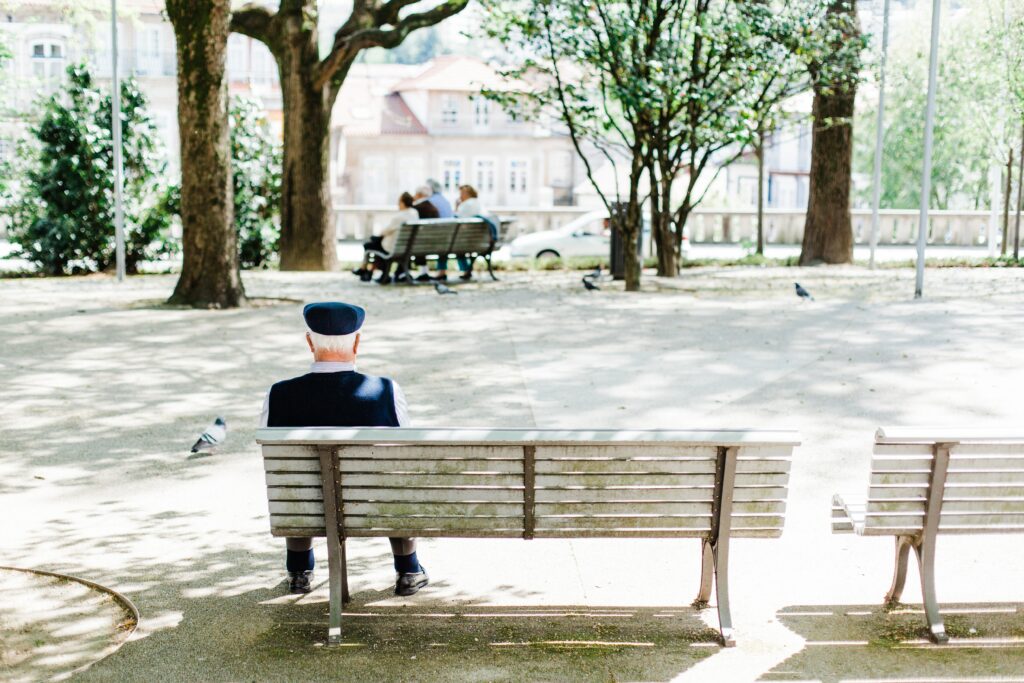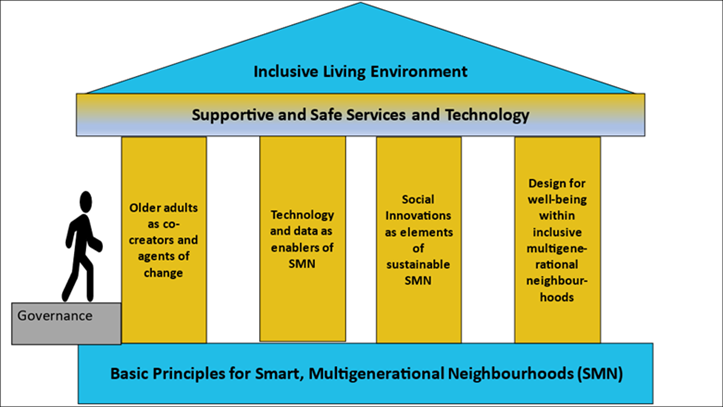The purpose of this article is to present a voluntary Code of Conduct for Smart Multigenerational Neighborhoods. This first version of the Code of Conduct was created collaboratively during the SHAPES project.
 Photo by Bruno Martins on Unsplash
Photo by Bruno Martins on Unsplash
Healthy Ageing and Smart Multigenerational Neighborhoods (SMNs)
As WHO Director-General, Dr Tedros states, “Fostering Healthy Ageing requires fundamental shifts – not just in the actions we take, but in how we think and feel towards age and ageing. The Decade of Healthy Ageing sends a clear signal that it is only by working as one, within the United Nations system and with governments, civil society and the private sector, that we will be able to not only add years to life, but also life to years.” (Agile Ageing Alliance 2022, 1).
An Agile Ageing Alliance (AAA) report ‘Cultivating Neighborhoods that Care’, published in association with ISO (The International Organization for Standardization), calls for the creation of a new globally recognised standard (ISO 25553) for multigenerational neighborhoods that foster healthy ageing and independent living, serving as a viable alternative to age-specific care in institutional settings. Central to this evolving standard is the design, creation, operation and maintenance of mixed tenure ‘Smart Multigenerational Neighborhoods’, where young and old, disabled and able, can co-exist in technologically enabled housing, designed to support healthy ageing and independent living, while improving quality of life for all residents. (Agile Ageing Alliance 2022; ISO/TC 314 Ageing Societies 2023). Digital Health & Care service systems can serve as powerful enablers to support healthy ageing and independent living in this new breed of Smart Multigenerational Neighborhood. According to Greenstone et al (2021) innovative solutions enabled by evolving technologies make it possible to adopt new business models among various sectors and stakeholders. ”Key paradigm is that digital innovation can enable, improve, support, augment and empower—but not replace—human communication and relationships”. (Greenstone et al 2021).
Code of Conduct for SMNs
As part of the SHAPES project and its ethics work (see SHAPES 2021) LAUREA has worked in collaboration with AAA and other stakeholders to co-create a voluntary Code of Conduct (CoC) for Smart Multigenerational Neighborhoods. The purpose of this evolving Code is to provide stakeholders, with a qualified set of guidelines and values, aligned to a mission, derived through a process of consultation across multiple disciplines and sectors, and which adopts also principles of Inclusive, Vibrant Neighborhoods and Communities. (see UN-Habitat 2023).
The background of this work is the idea of understanding ethics as a way to provide value to the various stakeholders of SMNs and their development. The core of this CoC is on human collaboration enabling the inclusion and empowerment of older adults and other people (especial minority groups and those living with some form of disability) regarding both administration and the co-creation and use of services and products, as well as structures of the living environment.
In addition to various normative documents and political papers, at the core of the development of this CoC is dialogue with various stakeholders, and thus both the top-down and bottom up -approaches are being factored into the equation. Co-creation of this Code of Conduct is needed to capture various viewpoints emerging from multidisciplinary and multicultural backgrounds. Both the process and the outcome are important in order to ensure that the practices presented in the CoC will be rooted in practical activities in multigenerational environments.
In practice the CoC will define ethical principles which are then further supplemented by guidelines, which assist in understanding and applying the principle. The CoC will promote ethically best practices when shaping our multigenerational neighborhoods of the future. Our intent is for the CoC to serve as the ‘governing ethos of an organization’ when it provides solutions in age-friendly neighborhoods (see Paine 1994).
The value base is established on the second and third generation of human rights and positive freedoms. Isaac Berlin in 1958 initially defined negative freedom as “freedom from”, the absence of constraints on the agent imposed by other people. Positive liberty is in turn “freedom to”, the ability to pursue and achieve a person’s own willed goals; and as autonomy or self-rule, as opposed to dependence on others. (see e.g. Stanford Encyclopedia of Philosophy 2023). The second generation rights including social, economic and cultural rights, presume a positive action of the State. The third generation of human rights concern collective rights, including economic and social development, healthy environment, natural resources, and participation in cultural heritage. Hence, such rights are positive and collective and demand responsibility (see e.g. Donarderki et al 2019). Positive freedom and 2. and 3. generation rights, which are relevant in the context of H&C services, underscore the political responsibility of the public sector, for example, in ensuring health and wellbeing.
Structure of the CoC
 Figure 1: Structure of the Code of Conduct (by Sarlio-Siintola)
Figure 1: Structure of the Code of Conduct (by Sarlio-Siintola)
Our CoC (see figure 1) is built using a temple metaphor. The temple describes a home and a neighborhood where the older person can live a good and active life within her/his own capacities and together with others, without the risk of exclusion.
Solid foundations are the starting point on which the code of conduct is built. Foundations are constructed on higher-level values and principles for SMN, stemming from international conventions and guidelines, including UN and WHO policy documents.
The roof beams consist of digital tools and services that enable older peoples good living in SMNs, SMN is the roof of the building.
The pillars are solid thanks to the foundations and give together (and only together) more practical advice for building SMNs, the roof and its beams.
Pillar “older adults as cocreators and agents of change” is essential in order to ensure that older adults will be empowered in SMNs and especially when making decisions regarding the services and the overall service provision, and when creating solutions which have impact on their lives.
Pillar “Design for wellbeing “ emphasizes the holistic approach to wellbeing and co-operation of various stakeholders (academia, business, NGOs, citizens) in the agile and real-time settings type of development of SMN solutions – for the built environment and/or services. Focus is on the methods and tools of co-creation to be used, and the stakeholders to be involved, in order to create common insight and to ensure balance of power in decision making.
Pillar ”Technology and data as enabler…”emphasizes the power of data both on the level of individual’s wellbeing and seamless services, and on the sustainability of ageing societies. It is focused on the possibilities and challenges relating to technology and data as sources of innovation and tools for the better life of older adults.
Pillar ”Social Innovations as elements of SMN” has the focus on how to foster and implement new ideas that meet social needs, create social relationships and form new collaborations. They are needed in order to make technology and data to create value, but also for such arrangements which might not need any commodities (such as technology). The ultimate end of social innovations is to help to create better futures in SMNS.
The Janitor is needed in order to keep the house in order. Correspondingly SMNs also need a sustainable governance strategy in which older adults are essential partners. Part of the janitor’s work is to update and put into practice this Code of Conduct.
Conclusions and next steps
The CoC for Smart Multigenerational Neighborhoods presented in this article is and will be a living document. Continuous co-creation is needed to capture various viewpoints emerging from multidisciplinary and multicultural backgrounds.
We look forward to evolving this Code of Conduct as an essential and accessible companion to the development of ISO 25553 Smart Multigenerational Neighbourhoods.
References
- Agile Ageing Alliance 2022. Cultivating Neighborhoods that Care. Referred 20th November.
- Greenhouse, E., Firestone, S., Spero, I. & Stone, M. 2021. Guiding principles for the built Environment – Cultivating Neighborhoods that care. A manifesto for Change, 12-19.
- Domaradzki, S., Khcostova, M. & Pupovac, D. 2019. Karel Vasak’s Generations of Rights and the Contemporary Human Rights Discourse. Human Rights Review, volume 20, 423-443.
- ISO/TC 314 Ageing Societies 2023. ISO 25553 Smart Multigenerational Neighbourhoods. Guidance and Requirements. Referred 20th November 2023.
- Paine, L. 1994. Managing for Organizational Integrity. Harvard Business Review 72 (2), 106-117.
- SHAPES 2021. SHAPES Ethical Framework. Referred 20th November 2023.
- Standford Encyclopedia of Philosophy 2023. Referred 20th November 2023.
- UN-Habitat 2023. UN Habitat’s Flagship Programmes. Referred 20th November 2023.